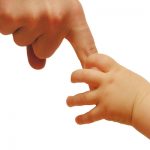 Now that your baby has gained head control and learned to roll over, she is ready to pull herself up to sit! This exciting milestone offers her a new way to move and a new view of her surroundings.
Now that your baby has gained head control and learned to roll over, she is ready to pull herself up to sit! This exciting milestone offers her a new way to move and a new view of her surroundings.
Like other gross-motor milestones before it, sitting up continues to prepare your baby for future movement (next up: crawling!). It nurtures her sensory-motor development and broadens her language acquisition, both of which we’ll talk about below.
Highlights:
|
When Do Babies Sit Up?
Around 6 months, you will be able to place your baby in a seated position and she will use her arms to support herself and stay there for limited periods of time. Around 7 months, she will have good balance while seated without using her arms as support, and may bend forward or backward to reach for things. Around 8 months, she will begin to pull herself up to sitting on her own.
Some babies reach these stages of sitting sooner, some later. If you’re worried about your baby’s development, your pediatrician can help determine if she’s on track.
Sitting and Other Gross-Motor Milestones
Pediatric Physical Therapist Dr. Andrea Hayward, MSPT, DPT explains that pulling up to sit on her own is an extraordinary feat for your baby. It requires a lot of pelvic, truck and arm strength to sit up, and a lot of balance and coordination to be able to twist, bend, lean, and play using both hands. All of this prepares her for her biggest gross-motor challenge yet: Crawling!
Sitting and Sensory-Motor Integration
Sitting is a big milestone for your baby’s “internal” senses—vestibular and proprioceptive, both of which are crucial for balanced, coordinated movement. The vestibular sense is an understanding of our bodies in space. It allows us to know how our body is positioned in relation to the ground and to objects around us. The proprioceptive sense is an understanding of the relative position of our body parts.
Pediatric Occupational Therapist Natasha Bravo, M.S., OTR/L explains that sitting refines these senses in important ways: It teaches your baby to understand that her body is vertical rather than horizontal, and that her head is further from the ground than when she is lying down. She learns how to use her body to transition from one position to another, shift weight from side to side, and catch herself from falling if she starts to topple over.
Language Development
Throughout our articles on gross-motor milestones we highlight how each offers new opportunities for your baby to have meaningful interactions with you during play. These interactions, according to Pediatric Speech-Language Pathologist Mandy Alvarez, M.S., CCC-SLP, are what drive her language development.
Sitting up brings a new, dynamic element to play. When your baby can pull to sit on her own and both of her hands are free, she can manipulate objects in a new way. She may hold an object in each hand and bang them together, or use her fingers to move objects across the floor. This creates new opportunities for you to label things and actions, narrate what’s happening, and engage in back-and-forth “conversation” with her. All of this teaches her about expressing herself, listening, cause and effect, and understanding non-verbal language.
Our BabySparks app has plenty of activities you can do with your baby to support her as she learns to get into and out of a seated position. Soon she will be on the move crawling, and you will be on the move keeping up with her!
[/vc_column_text][/vc_column][/vc_row]








